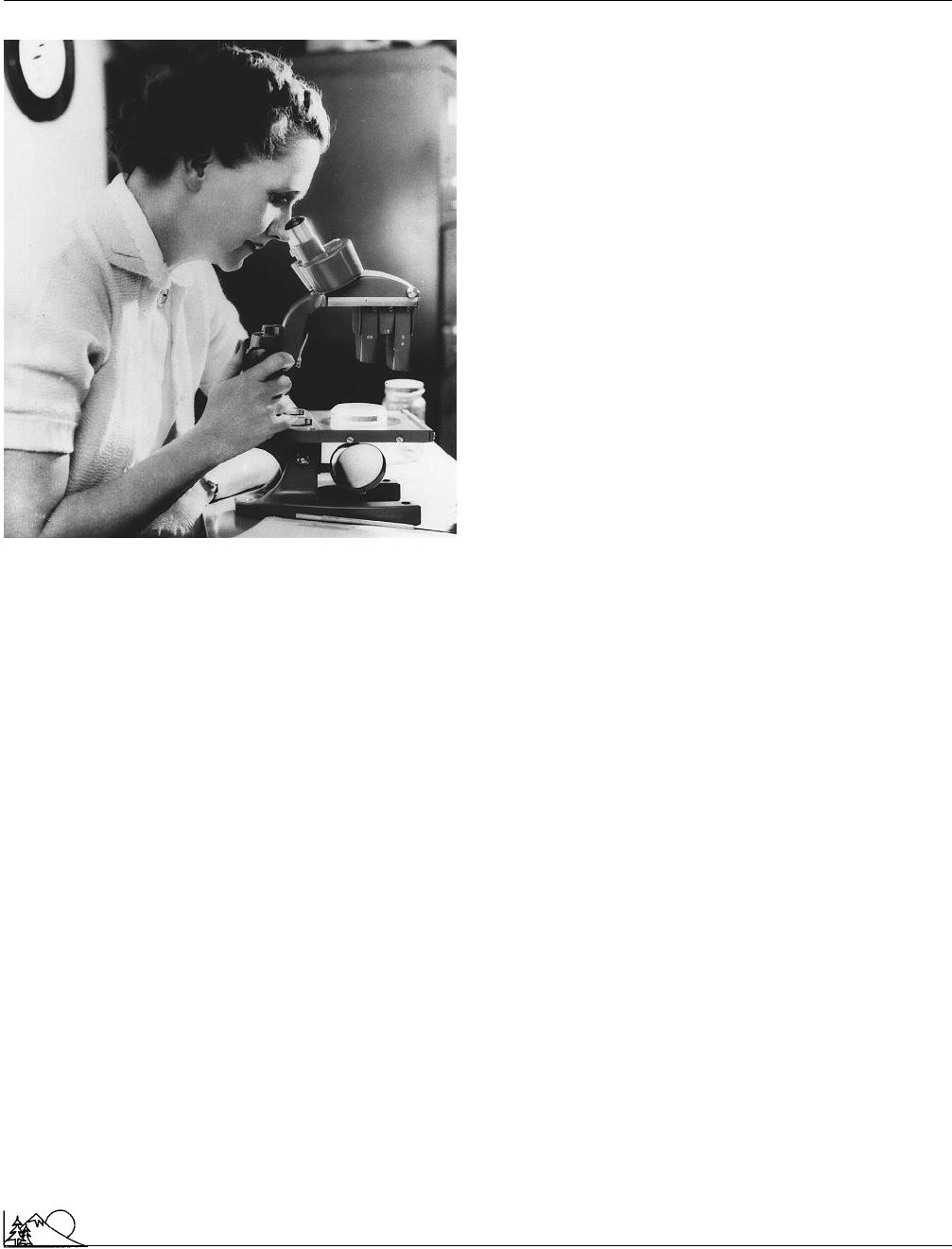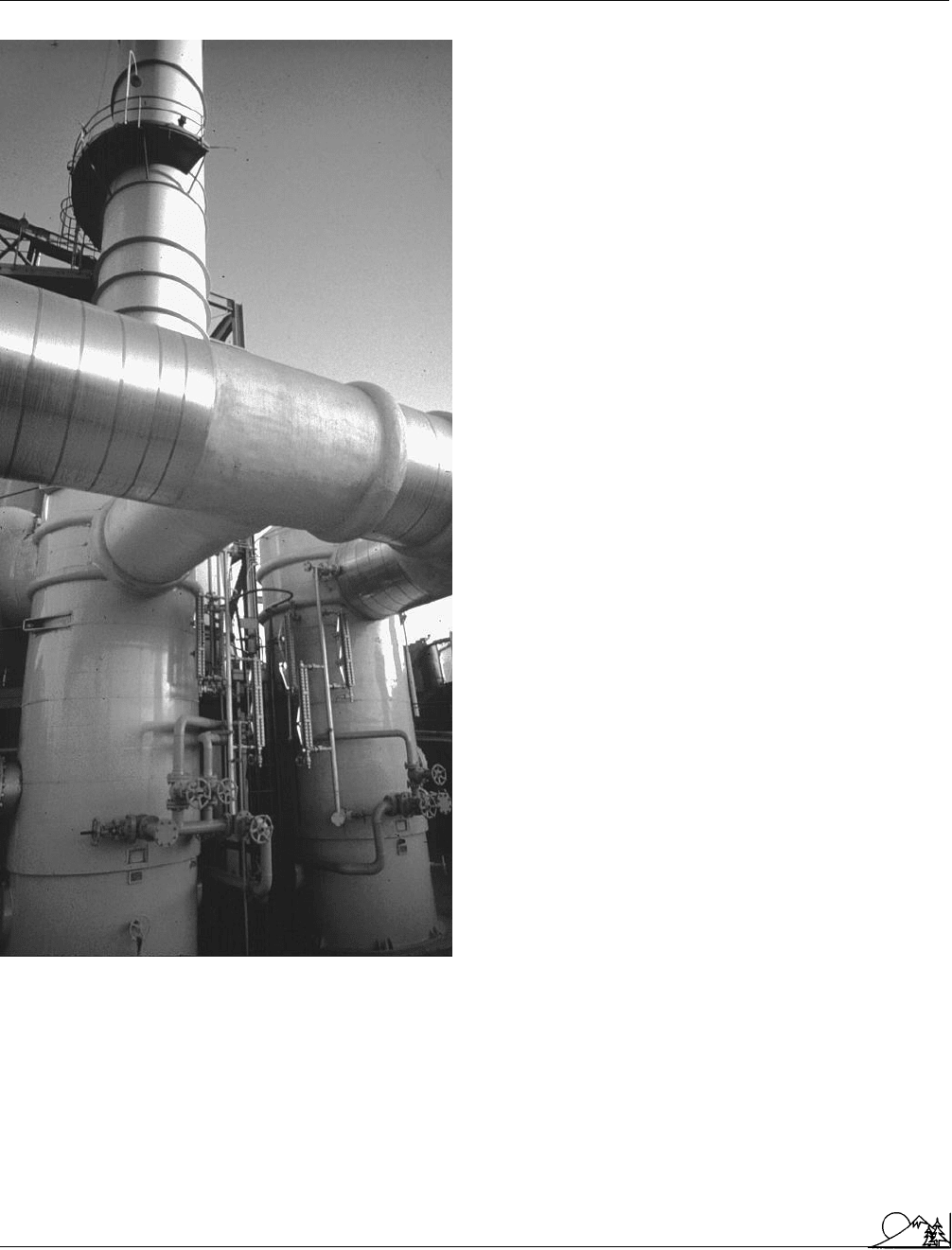Environmental Encyclopedia
Подождите немного. Документ загружается.


Environmental Encyclopedia 3
Carbon tax
McPherson, E.G. “Using Urban Forests For Energy Efficiency And Carbon
Storage.” Journal of Forestry 94 (1994): 36-41.
Sampson, R.N., et al. “ Biomass Management and Energy.” Water, Air,
Soil Pollution. 70 (1993): 139-159.
Carbon tax
To limit and control the amount of
carbon dioxide
(CO
2
)
added to the
atmosphere
, special taxes, called
carbon
taxes,
have been proposed and in some cases adopted, on fuels
containing carbon. Fuels such as
coal
,
gasoline
, heating
oil, and
natural gas
, release energy by combining the carbon
they contain with oxygen in the air, to produce carbon diox-
ide. Increased use of carbon-containing
fossil fuels
in mod-
ern times has greatly increased the rate at which carbon
dioxide is entering the atmosphere. Measurable increases in
atmospheric levels of the gas have been detected. Since car-
bon dioxide is the principle component of so-called
green-
house gases
, changes in its concentration in the earth’s
atmosphere are a concern. Increases in the level of carbon
dioxide, and other greenhouse gases such as
methane
,
ni-
trous oxide
,
ozone
, and man-made
chlorofluorocarbons
can be expected to result in warmer temperatures on the
surface of the earth, and wide-ranging changes in the global
climate
. Greenhouse gases permit radiation from the Sun
to reach the earth’s surface but prevent the infrared or heat
component of sunlight from re-irradiating into space.
The wide spread concern over the possible climatic
effects of increases in heat-trapping gases in the atmosphere
was exemplified by a 1994 report of the
Intergovernmental
Panel on Climate Change
(IPCC) which concluded that
unless greenhouse gas emissions were curtailed, average
global temperatures would rise 2.5–8.1° F (1.4–4.5° C) by
the year 2100. A 20% reduction in emissions over 20 years
was recommended and considered feasible in developed
countries. It was recognized that the rapidly expanding econ-
omies of many developing countries makes similar reductions
less likely.
While limiting the buildup of heat-trapping gases in
the atmosphere has been a goal of natural scientists for some
time, many economists have now joined the effort. In 1997,
2,000 prominent economists, including six Nobel Laureates,
signed the “Economists’ Statement on Climate Change”
stating that policies to slow global warming are needed and
are economically viable. The economists agreed with a review
conducted by a distinguished international panel of scientists
under the auspices of the IPCC that, “The balance of evi-
dence suggests a discernible human influence on global cli-
mate.” They further stated that, “As economists, we believe
that global climate change carries with it significant environ-
mental, economic, social, and geopolitical risks, and that
preventive steps are justified.” They state that economic
217
studies have found that potential policies to reduce green-
house-gas emissions can be designed so that benefits out-
weigh costs, and living standards would not be harmed.
They claim that United States productivity may actually
improve as a result. The statement goes on to claim that,
“the most efficient approach to slowing climate change is
through market-based policies” rather than limits or regula-
tions. The economists also suggest that, “A cooperative ap-
proach among nations is required, such as an international
emissions trading agreement.” They recommend, “market
mechanisms such as carbon taxes or the auction of emissions
permits.” Their statement goes on to suggest that, “Revenues
generated from such policies can effectively be used to reduce
budget deficits or lower existing taxes.” New taxes are never
popular, but are more apt to be accepted when the revenue
is used to replace other taxes or to aid the
environment
.
As in any public policy debate, views of even well-
qualified experts are often sharply divided. Some industry
representatives and scientists are unwilling to accept the
premise that greenhouse gas emissions represent a serious
threat. Industrial spokesmen continue to claim that efforts
to reduce greenhouse gas emissions through taxation or other
economic means are not cost effective, and would devastate
the economy, cost jobs, and reduce living standards. Individ-
ual countries worry about the impacts on their competitive-
ness if other countries do not adopt similar measures. The
potential impact on low-income groups must also be consid-
ered. Some are concerned that the taxes have to be high to
be effective. The amount of year to year variation in climate
and temperature throughout the globe, provide ample room
for differences of opinion.
International attention was focused on the need to
reduce greenhouse gases at the United Nations sponsored
Earth Summit held in Rio de Janeiro in 1992. The confer-
ence was held to attempt to reconcile worldwide economic
development with the need to preserve the environment.
Representatives of 178 nations attended, including 117 heads
of state, making it the largest gathering of world leaders in
history. Documents and treaties were signed committing
most of the world’s nations to the economic development
in ways that were compatible with a healthy environment.
A binding treaty called “The Framework Convention on
Climate Change, or Global Warming Convention” was
adopted, requiring nations to reduce emissions of greenhouse
gases. The treaty failed to set binding targets for
emission
reductions, however. Agreement was hampered by discord
between industrialized nations of western Europe, and North
America and developing nations in Africa, Latin America,
the Middle East and Asia. Developing countries were con-
cerned that environmental restrictions would hamper eco-
nomic growth unless they received increased aid from devel-

Environmental Encyclopedia 3
Carcinogen
oped nations to enable them to grow in an environmentally
sound way.
National and regional efforts to limit greenhouse gas
has been most evident in western Europe, although disagree-
ments between countries have prevented a unified approach
among members of the European Community (EC). Britain
has refused to accept a proposed carbon and energy tax,
favored by several nations. Spokesmen for Britain expressed
doubt that the tax would achieve desired reductions, and
claimed that the two-thirds reduction in emissions to which
Britain was committed would result from a planned enact-
ment of a value-added tax (VAT) on fuel and energy. Critics
of Britain’s position argued that their plan was not suffi-
ciently focused because it did not specially target fuels that
increase atmospheric carbon dioxide. A 1996 report from the
European Environmental Agency (EEA) in Copenhagen
concluded that “green taxes” adopted by individual European
countries in the last decade have been successful. So-called
green taxes
are a variety of environmentally friendly tax
measures intended to reduce
pollution
and toxic wastes and
encourage efficient resource use. Carbon taxes, such as those
enacted in Norway and Sweden in 1991, are one example.
Other examples include taxes on sulfur and
nitrogen
oxide
emissions,
water pollution
charges, and charges for
house-
hold waste
. The carbon dioxide tax in Norway was reported
to have reduced CO
2
emissions by 3–4%. The goal in the
Scandinavian countries and the Netherlands has been to
move away from taxes on labor or capital to those on
energy
and the environment
. The consensus in western Europe
seems to be that current environmental policies are weighted
too much in the direction of regulation, and that there is a
need to provide economic incentives in the form of well-
designed environmental taxes.
Although eastern European countries have moved for-
ward more slowly than in the rest of the continent, Poland,
Hungary, and Estonia are beginning to adopt environmental
charges and taxes. In the far-east, the Japanese Environmen-
tal Agency has reported that Japan might be able to keep
per capita emissions of carbon dioxide at 1990 levels, which
would result in a small increase in total emissions because
of
population growth
.
The effectiveness of green taxes, including carbon
taxes, is not universally accepted. Some argue that goals
need to be defined more carefully with specified amounts
or percentages of reduction in targeted pollutants. The EEA
report acknowledges that the evaluation of the effectiveness
is difficult and that, “Judgments about the performance of
green taxes remain at the level of best guesses.” Although
theoretical evaluation of environmental taxation is well-de-
veloped, adequate evaluation of practical experience with
such taxes is still relatively rare. Proper evaluation must
separate the effects of green taxes from other factors, and
218
assess what would have happened without the taxes. It is
also recognized that it may take as much as a decade for a
tax to have the desired effect.
In the United States, the Clinton administration, in
1993, published a 50-point plan to reduce greenhouse gas
emissions by 100 million tons through a number of voluntary
measures. Among the steps recommended were greater
en-
ergy efficiency
in homes and electrical appliances, reduced
emissions from
power plants
, greater reliance on hydroelec-
tric power, and increased tree planting. Some observers be-
lieve that the prospects for “green taxes” are less favorable
in the United States than in Europe because of difficulty of
passing legislation through two houses of Congress, which
may be controlled by different parties, and obtaining ap-
proval by the president. Some individual states, however,
have enacted measures that create economic incentives for
environmental protection. Louisiana, which has many
pet-
rochemical
companies within its borders, created an “envi-
ronmental scorecard” in 1991, to keep a tally of companies’
toxic discharges, waste volumes, and compliance with envi-
ronmental laws. Graded exemptions from property taxes are
granted to companies with good scores. Oregon’s Energy
Facility Siting Task Force recommended establishment of
a standard to reduce emissions of carbon dioxide, with provi-
sions for offsets for planting trees (which remove CO
2
from
the air), and for the use of
renewable energy
sources.
[Douglas C. Pratt]
R
ESOURCES
P
ERIODICALS
Burke, M. “Environmental Taxes Gaining Ground in Europe.” Environ-
mental Science & Technology 31 (1997): 84-88.
Environmental Taxes: Implementation and Environmental Effectiveness;
Environmental Issue Series No. 1. European Environment Agency: Copenha-
gen, 1996.
Carcinogen
A carcinogen is any substance or agent that produces or
induces the development of
cancer
. Carcinogens are known
to affect and initiate metabolic processes at the level of
cellular DNA.
Cancer accounts for slightly over 20% of all deaths
each year. It is estimated that one out of every four Americans
will develop cancer eventually and that six out of 10 in this
group will die from the disease itself or complications arising
from the disease. Half of all cancer deaths occur before the
age of 65. Among women between 30 and 40 and children
between three and 14, cancer is the leading cause of death
next to accidents. It is the most frequent cause of death
among Americans under 35 years of age.

Environmental Encyclopedia 3
Carcinogen
The testing of
chemicals
as cancer-producing agents
began with the observation of Sir Percival Pott in 1775 that
scrotal cancer in young chimney sweeps resulted from the
lodgement of soot in the folds of their scrotums. Pott was
the first to link an environmental agent,
coal
tar, to cancer
growth. In 1918 scientists began to test chemical derivatives
for their cancer-causing efficacy. These first experiments
looked at polycyclic
hydrocarbons
, specifically benzo(a)-
pyrene found in coal tar, and they demonstrated that a certain
degree of exposure to coal tar produced cancer in laboratory
rats. In 1908, Vilhelm Ellerman and Oluf Bang of Denmark
reported that an infectious agent could cause cancer, after
they found that a leukemia-like blood disease was transmit-
ted among domestic fowl via a
virus
. In 1911, Peyton Rous
established a viral cause for a cancer called sarcoma in domes-
tic fowl, and he was awarded a Nobel Prize for this discovery
some 55 years later. In 1932, Lacassagne reported that estro-
gen injections caused mammary cancer in mice. This opened
up investigation into the role hormones played in the devel-
opment of various types of cancers.
In 1896, Wilhelm Roentgen discovered the x ray, a
radioactive
emission
capable of penetrating many solid ma-
terials including the human body. x rays quickly found use
as a diagnostic tool in medicine; but operators of x ray
devices, unaware of their harmful effects, determined the
proper intensity of the beams by repeatedly exposing their
hands to the rays. Many operators of x ray equipment began
to suffer from cancer of the hand, and Roentgen himself
died of cancer. The most dramatic environmental link to
cancer induced by
radioactivity
was observed after the
bombing of
Hiroshima, Japan
when there was a radical
increase in
leukemia
type cancers among people exposed
to the atomic blast.
Environmental agents such as toxic chemicals and ra-
diation are considered responsible for about 85% of all cancer
cases. A great many environmental agents such as synthetic
chemicals, sunlight (exposure to UV and UVB rays), air
pollutants,
heavy metals
, x rays, high-fat diet, chemical
pesticides, and cigarette smoking are known to be carcino-
genic. Surveys carried out on the geographic incidence of
cancer indicate that certain types of cancer are far more
common in heavily industrialized areas. New Jersey, the site
of approximately 1,200 chemical plants and related indus-
tries, has the highest overall cancer rate in the United States.
Tobacco
use, particularly cigarette smoking, is now
recognized as the leading contributor to cancer
mortality
in the United States. Currently one third of all cancer deaths
are due to lung cancer, and of the 130,000 new lung cancer
victims diagnosed each year, 80% are cigarette smokers. Sev-
eral years ago, the primary cause of cancer among women
was breast cancer—but by the late 1980s, lung cancer had
surpassed breast cancer as the leading cause of death among
219
women. Current controversy rages over the role of secondary
smoke
as a contributing cause of cancer among nonsmokers
exposed to
cigarette smoke
.
Dietary factors have been extensively investigated, and
experiments have implicated everything from coffee to char-
coal broiled meat to peanut butter as possible carcinogens.
A major concern among meat producers was the use of
diethylstilbestrol (DES) as a source for beefing up cattle.
DES is a synthetic hormone that increases the rate of growth
in cattle. In the 1960s, DES was fed to about three fourths
of all the cattle raised in the United States. It was also used
to prevent miscarriages in women until 1966, when it was
shown to be carcinogenic in mice. DES is now linked to
vaginal and cervical cancers in women born between 1950
and 1966 whose mothers took DES during their preg-
nancies.
In 1971, DES was banned for use in cattle by the
Food and Drug Administration
(FDA), but the federal
courts reversed the ban, contending that DES posed no
danger since it was not directly added to foods but was
administered only to cattle. When the FDA subsequently
showed that measurable quantities remained present in
slaughtered cattle, the courts reinstated the ban. But the
issue of using growth additives in meat production remains
unresolved today. Environmentalists are still concerned that
known carcinogenic chemicals used to “beef up” cattle are
being consumed by humans in various meat products, though
no direct links have yet been established. In addition, various
food additives
, such as coal tar dyes used for artificial
coloring and food preservatives, have produced cancer in
laboratory animals. As yet there is no evidence indicating
that human cancer rates are rising because of these substances
in food.
Air pollution
has been extensively investigated as a
possible carcinogen and it is known that people living in
cities larger than 50,000 run a 33% higher risk of developing
lung cancer than people who live in other areas. The reasons
behind this phenomenon, referred to as the “urban factor,”
have never been conclusively determined. Areas with popula-
tions exceeding 50,000 tend to have more industry, and air
pollutants can have a profound effect in regions such as New
Jersey where they are highly concentrated.
Occupational exposure to carcinogenic substances ac-
counts for an estimated 2–8% of diagnosed cancers in the
United States. Until passage of the Toxic Substances Control
Act in 1976, which gave the federal government the power
to require testing of potentially hazardous substances before
they go on the market, hundreds of new chemicals with
unknown side effects came into industrial use each year.
Substances such as
asbestos
are estimated to cause 30–40%
of all deaths among workers who have been exposed to
it.
Vinyl chloride
, a basic ingredient in the production of

Environmental Encyclopedia 3
Carrying capacity
plastics
, was found in 1974 to induce a rare form of liver
cancer among exposed workers. Anaesthetic gases used in
operating rooms have been traced as the reason nurse anes-
thetists develop leukemia and lymphoma at three times the
normal rate with an associated higher rate of miscarriage and
birth defects
among their children.
Benzene
, an industrial
chemical long known as a bone-marrow poison, has been
shown to induce leukemia as well. A major step forward in
the regulation of these potential cancer causing agents is
the implementation by the Occupational Safety and Health
Administrations (OSHA) of the Hazard Communication
Standard in 1983, intended to provide employees in manu-
facturing industries access to information concerning haz-
ardous chemicals encountered in the workplace.
With the
erosion
of the
ozone
layer of our
atmo-
sphere
, increased concern about over-exposure to
ultravio-
let radiation
and its subsequent effect on the formation of
skin cancer has developed. The EPA estimates that a five%
ozone depletion in the
stratosphere
would result in a sub-
stantial increase in a variety of skin cancers. This would
include an average of two million extra cases of basal-cell
and squamous-cell skin cancers a year and an additional
30,000 cases of the often fatal melanoma skin cancer, which
currently kills 9,000 Americans per year. See also Hazardous
waste siting; Love Canal, New York; Ozone layer depletion;
Radiation exposure; Radiation sickness; Radon; Toxic sub-
stance
[Brian R. Barthel]
R
ESOURCES
B
OOKS
Aldrich, T., and J. Griffith. Environmental Epidemiology. New York: Van
Nostrand Reinhold, 1993.
McCance, K. L. Pathophysiology: the Biological Basis for Disease in Adults
and Children. St. Louis: Mosby, 1990.
National Academy of Sciences. Ozone Depletion, Greenhouse Gases and Cli-
mate Change. Washington, DC: U. S. Environmental Protection
Agency, 1989.
U. S. Environmental Protection Agency. The Potential Effects of Global
Climate Change on the United States. Washington, DC: U. S. Government
Printing Office, 1988.
Carrying capacity
Carrying capacity is a general concept based on the idea that
every
ecosystem
has a limit for use that cannot be exceeded
without damaging the system. Whatever the specified use
of an area might be, whether for grazing,
wildlife habitat
,
recreation
, or economic development, there is a threshold
that cannot be breached, except temporarily, without degrad-
ing the ability of the
environment
to support that use.
Examinations of carrying capacity attempt to determine,
220
with varying degrees of
accuracy
, where this threshold lies
and what the consequences of exceeding it might be.
The concept of carrying capacity was pioneered early
this century in studies of range management and
wildlife
management
. Range surveys of what was then called “graz-
ing capacity” were carried out on the Kaibab Plateau in
Arizona as early as 1911, and this term was used in most
of the early bulletins issued by the
U.S. Department of
Agriculture
on the subject. In his 1923 classic, Range and
Pasture Management, Sampson defined grazing capacity as
“the number of stock of one or more classes which the area
will support in good condition during the time that the
forage is palatable and accessible, without decreasing the
forage production in subsequent seasons.” Sampson was
quick to point out that the “grazing capacity equation has
not been worked out on any range unit with mathematical
precision.” In fact, because of the number of variables in-
volved, especially variables stemming from human actions,
he did not believe that the “grazing-capacity factor will ever
be worked out to a high degree of scientific accuracy.” Samp-
son also pointed out that “grazing the pasture to its very
maximum year after year can produce only one result—a
sharp decline in its carrying capacity,” and he criticized the
stocking of lands at their maximum instead of their optimum
capacity. Similar discussions of carrying capacity can be
found in books about wildlife management from the same
period, particularly Game Management by
Aldo Leopold
,
published in 1933.
Practitioners of applied
ecology
have calculated the
number of animal-unit months that any given land area can
carry over any given period of time. But there have been
some controversies over the application of the concept of
carrying capacity. The concept is commonly employed with-
out considering the factor of time, neglecting the fact that
carrying capacity refers to
land use
that is sustainable. An-
other common mistake is to confuse or ignore the implicit
distinctions between maximum, minimum, and optimum
capacity. In discussions of land use and environmental im-
pact, some officials have drawn graphs with curves showing
maximum use of an area and claimed that these figures
represent carrying capacity. Such representations are mis-
leading because they assume a perfectly controlled popula-
tion, one without fluctuation, which is not likely. In addition,
the maximum allowable population can almost never be the
carrying capacity of an area, because such a number can
almost never be sustained under all possible conditions. A
population in balance with the environment will usually
fluctuate around a mean, higher or lower, depending on
seasonal habitat conditions, including factors critical to the
support of that particular
species
or community.
The concept of carrying capacity has important ramifi-
cations for
human ecology
and
population growth
. Many

Environmental Encyclopedia 3
Rachel Louise Carson
of the essential systems on which humans depend for suste-
nance are showing signs of stress, yet demands on these
systems are constantly increasing. William R. Catton has
formulated an important axiom for carrying capacity: “For
any use of any environment there is a use intensity that
cannot be exceeded without reducing that environment’s
suitability for that use.” He then defined carrying capacity
for humans on the basis of this axiom: “The maximum
human population equipped with a given assortment of tech-
nologies and a given pattern of organization that a particular
environment can support indefinitely.”
The concept of carrying capacity is the foundation for
recent interest in
sustainable development
, an environ-
mental approach which identifies thresholds for economic
growth and increases in human population. Sustainable de-
velopment calculates the carrying capacity of the environ-
ment based on the size of the population, the standard of
living desired, the overall quality of life, the quantity and
type of artifacts created, and the demand on energy and
other resources. With his calculations on sustainable devel-
opment in Paraguay, Herman Daly has illustrated that it is
possible to work out rough estimates of carrying capacity
for some human populations in certain areas. He based his
figures on the ecological differences between the country’s
two major regions, as well as on differences among types of
settlers, and differences between developed good land and
undeveloped marginal lands.
If ecological as well as economic and social factors are
taken into consideration, then any given environment has
an identifiable tolerance for human use and development,
even if that number is not now known. For this reason,
many environmentalists argue that carrying capacity should
always be the basis for what has been called “demographic
accounting.”
[Gerald L. Young and Douglas Smith]
R
ESOURCES
B
OOKS
Edwards, R. Y., and C. D. Fowle. “The Concept of Carrying Capacity.”
In Readings in Wildlife Management, edited by J. A. Bailey, W. Elder, and
T. D. McKinney. Washington, DC: The Wildlife Society, 1974.
P
ERIODICALS
Budd, W. W. “What Capacity the Land?” Journal of Soil and Water Conser-
vation 47 (January-February 1992): 28-31.
Catton, W. R., Jr. “The World’s Most Polymorphic Species: Carrying
Capacity Transgressed Two Ways.” BioScience 37 (June 1987): 413-419.
Graefe, A. R., J. V. Vaske, and F. R. Kuss. “Social Carrying Capacity: An
Integration & Synthesis of Twenty Years of Research.” Leisure Sciences 6
(December 1984): 395-431.
221
Nilsson, S. “The Carrying Capacity Concept.” Interdisciplinary Science Re-
views 9 (June 1984): 137-148.
Rachel Louise Carson (1907 – 1964)
American ecologist, marine biologist, and writer
Rachel Louise Carson was a university-trained biologist, a
longtime United States government employee, and a best-
selling author of such books as Edge of the Sea, The Sea
Around Us (a National Book Award winner), and Silent
Spring.
Her book on the dangers of misusing pesticides, Silent
Spring, has become a classic of environmental literature and
resulted in her recognition as the fountainhead of modern
environmentalism
. Silent Spring was reissued in a twenty-
fifth anniversary edition in 1987, and remains standard read-
ing for anyone concerned about environmental issues.
Carson grew up in the Pennsylvania countryside and
reportedly developed an early interest in
nature
from her
mother and from exploring the woods and fields around her
home. She was first an English major in college, but a
required course in biology rekindled that early interest in
the subject and she graduated in 1928 from Pennsylvania
College for Women with a degree in zoology and went on
to earn a master’s degree at Johns Hopkins University. After
the publication of Silent Spring, she was often criticized for
being a “popular science writer” rather than a trained biolo-
gist, making it obvious that her critics were unaware of her
university work, including a master’s thesis entitled “The
Development of the Pronephros During the Embryonic and
Early Larval Life of the Catfish (Ictalurus punctatus).”
Summer work also included biological studies at
Woods Hole Marine Biological Laboratory in Massachu-
setts, where she became more interested in the life of the
sea. After doing a stint as a part-time scriptwriter for the
Bureau of Fisheries, she was hired full-time as a junior
aquatic biologist. When she resigned from the United States
Fish and Wildlife Service
in 1952 to devote her time to
her writing, she was biologist and chief editor there. First,
as a biologist and writer with the Bureau and then as a
free-lance writer and biologist, she successfully combined
professionally the two great loves of her life, biology and
writing.
Often described as “a book about death which exalts
life,” Silent Spring is the work on which Carson’s position as
the modern catalyst of a renewed environmental movement
rests. The book begins with a shocking fable of one compos-
ite town’s “silent spring” after pesticides have decimated
insects and the birds that feed upon them. The main part
of the book is a massive documentation of the effects of
organic pesticides on all kinds of life, including birds and

Environmental Encyclopedia 3
Rachel Louise Carson
humans. The final sections are quite restrained, drawing a
hopeful picture of the future, if feasible alternatives to the
use of pesticides—such as biological controls—are used in
conjunction with and as a partial replacement of chemical
sprays.
Carson was quite conservative throughout the book,
being careful to limit examples to those that could be verified
and defended. In fact, there was very little new in the book;
it was all available earlier in a variety of scientific publications.
But her science background allowed her to judge the credibil-
ity of the facts she uncovered and provided sufficient knowl-
edge to synthesize a large amount of data. Her literary skills
made that data accessible to the general public.
Silent Spring was not a polemic against all use of pesti-
cides but a reasoned argument that potential hazards be
carefully and sufficiently considered before any such chemical
was approved for use. Many people date modern concern
with environmental issues from her argument in this book
that “future generations are unlikely to condone our lack of
prudent concern for the integrity of the natural world that
supports all life.” It is not an accident that her book is
dedicated to
Albert Schweitzer
, because she wrote it from
a shared philosophy of reverence for life.
Carson provided an early outline of the potential of
using biological controls in place of
chemicals
, or in concert
with smaller doses of chemicals, an approach now called
integrated pest management
. She worried that too many
specialists were concerned only about the effectiveness of
chemicals in destroying pests and “the overall picture” was
being lost, in fact not valued or even sought. She pointed
out the false safety of assuming that products considered
individually were safe, when in concert, or synergistically,
they could lead to human health problems.
Her
holistic approach
was one of the real, and un-
usual, strengths of the book. Prior to the publication of
Silent Spring, she even refused to appear on a
National
Audubon Society
panel on pesticides because such an ap-
pearance could provide a forum for only part of the picture
and she wanted her material to first appear “as a whole.”
She did allow it to be partially serialized in The New Yorker,
but articles in that magazine are long and detailed.
The book was criticized early and often, and often
viciously and unfairly. One chemical company, reacting to
that pre-publication serialization, tried to get Houghton
Mifflin not to publish the book, citing Carson as one of the
“sinister influences” trying to reduce the use of
agricultural
chemicals
so that United States food supplies would dwindle
to the level of a developing nation. The chemical industry
apparently united against Carson, distributing critical re-
views and threatening to withdraw magazine advertisements
from journals deemed friendly to her. Words and phrases
used in the attacks included “ignorant,” “biased,” “sensa-
222
tional,” “unfounded,” “distorted,” “not written by a scientist,”
“littered with crass assumptions and gross misinterpreta-
tions,” to name but a few.
Some balanced reviews were also published, most
noteworthy one by Cornell University ecologist LaMont
Cole in Scientific American. Cole identified errors in her
book, but finished by saying “errors of fact are so infrequent,
trivial and irrelevant to the main theme that it would be
ungallant to dwell on them,” and went on to suggest that
the book be widely read in the hopes that it “may help us
toward a much needed reappraisal of current policies and
practices.” That was the spirit in which Carson wrote Silent
Spring and reappraisals and new policies were indeed the
result of the myriad of reassessments and studies spawned
by its publication. To its credit, it did not take the science
community long to recognize her credibility; the President’s
Science Advisory Committee issued a 1963 report that the
journal Science suggested “adds up to a fairly thorough-going
vindication of Rachel Carson’s Silent Spring thesis.”
While it is important to recognize the importance of
Silent Spring as a landmark in the environmental movement,
one should not neglect the significance of her other work,
especially her three books on oceans and marine life and the
impact of her writing on people’s awareness of one of earth’s
great natural ecosystems.
Under the Sea Wind (1941) was Carson’s attempt “to
make the sea and its life as vivid a reality [for her readers] as
it has become for me.” And readers are given vivid narratives
about the shore, including vegetation and birds, on the open
sea, especially by tracing the movements of the mackerel,
and on the sea bottom, again by focusing on an example, this
time the eel. The Sea Around Us (1951) continues Carson’s
treatment of marine biology, adding an account of the history
and development of the sea and its physical features such
as islands and tides. She also includes human perceptions
of and relationships with the sea. The Edge of the Sea (1955)
was written as a popular guide to beaches and sea shores,
but focusing on rocky shores, sand beaches, and coral and
mangrove coasts, it complemented the physical descriptions
in The Sea Around Us with biological data.
Carson was a careful and thorough scientist, an inspir-
ing author, and a pioneering environmentalist. Her
groundbreaking book, and the controversy it generated, was
the catalyst for much more serious and detailed looks at
environmental issues, including increased governmental in-
vestigation that led to creation of the
Environmental Pro-
tection Agency
(EPA). Her work will remain a hallmark
in the increasing awareness modern people are gaining of
how humans interact with and impact the
environment
in
which they live and on which they depend.
[Gerald R. Young]

Environmental Encyclopedia 3
Catalytic converter
Rachel Carson. (Corbis-Bettmann. Reproduced by per-
mission.)
R
ESOURCES
B
OOKS
Bonta, M. M. “Rachel Carson, Pioneering Ecologist.” In Women in the
Field: America’s Pioneering Naturalists. College Station, TX: Texas A & M
University Press, 1991.
Brooks, P. The House of Life: Rachel Carson at Work. Boston: Houghton
Mifflin, 1972.
Carson, Rachel. Silent Spring. Boston: Houghton Mifflin, 1962.
Downs, R. B. “Upsetting the Balance of Nature: Rachel Carson’s Silent
Spring.” In Books That Changed America. New York: Macmillan, 1970.
Hynes, H. P. The Recurring Silent Spring. New York: Pergamon Press, 1989.
Marco, G. J., R. M. Hollingworth, and W. Durham. Silent Spring Revisited.
Washington, DC: American Chemical Society, 1987.
P
ERIODICALS
Graham Jr., F. “Rachel Carson.” EPA Journal 4 (November–December
1978): 5–7+.
Cash crop
A crop that is produced for the purpose of exporting or
selling rather than for consumption by the person who grows
it. In many
Third World
countries, cash crops often replace
the production of basic food staples such as rice, wheat, or
223
corn in order to generate foreign exchange. For example, in
Guatemala, much of the land is devoted to the production of
bananas and citrus fruits (97% of the citrus crop is exported),
which means that majority of the basic food products needed
by the native people are imported from other countries.
Often these foods are expensive and difficult for many poor
people to obtain. Cash crop agriculture also forces many
subsistence and tenant farmers to give up their land in order
to make room for industrialized farming.
Catalytic converter
Catalytic converters are devices which employ a catalyst
to facilitate a chemical reaction. (A catalyst is a substance
that changes the rate of a chemical reaction, but whose
own composition is unchanged by that reaction.) For
air
pollution control
purposes, such reactions involve the
reduction of nitric oxide to molecular oxygen and
nitrogen
or oxidation of
hydrocarbons
and
carbon monoxide
to
carbon dioxide
and water. Using the catalyst, the activa-
tion energy of the desired chemical reaction is lowered.
Therefore, exothermic chemical conversion will be favored
at a lower temperature.
Traditional catalysts have normally been metallic, al-
though nonmetallic materials, such as ceramics, have been
coming into use in recent years. Metals used as catalysts
may include noble metals, such as platinum, or
base
metals,
including
nickel
and
copper
. Some catalysts are more effec-
tive in oxidation, others are more effective in reduction.
Some metals are effective in both kinds of reactions. The
catalyst material is normally coated on a porous, inert support
structure of varying design. Examples include honeycomb
ceramic structures with long channels and pellet beds. The
goal is to channel exhaust over a large surface area of catalyst
without an unacceptable pressure drop.
In some cases, reduction and oxidation catalysts are
combined to control oxides of nitric oxide,
carbon
monox-
ide, and hydrocarbon emissions in exhaust from internal
combustion
engines. The reduction and oxidation processes
can be conducted sequentially or simultaneously. Dual cata-
lysts are used in sequential reduction-oxidation. In this case,
the exhaust gas from a rich-burn engine initially enters the
reducing catalyst to reduce nitric oxide. Subsequently, as the
exhaust enters an oxidation catalyst, it is diluted with air
to provide oxygen for oxidation. Alternatively, three-way
catalysts can be used for simultaneous reduction and oxida-
tion. Engines exhausting to such catalysts run slightly rich
and require tight regulation of air-fuel ratio.

Environmental Encyclopedia 3
Catskill Watershed Protection Plan
A catalytic converter at a large petrochemical
plant. (Phototgraph by Tom Carroll. Phototake. Repro-
duced by permission.)
Reducing catalysts can be made more efficient using
a reducing agent, such as ammonia. This method of control,
referred to as selective catalytic reduction, has been employed
successfully on large turbines. In this case, a reducing agent
224
is introduced upstream of a reducing catalyst, allowing for
greater rates of nitric oxide reduction.
[Robert B. Giorgis Jr.]
R
ESOURCES
B
OOKS
Silver, R. G., ed. Catalytic Control of Air Pollution: Mobile and Stationary
Sources. Washington, DC: American Chemical Society, 1992.
Yaverbaum, L. H. Nitrogen Oxides Control and Removal: Recent Develop-
ments. Park Ridge, NJ: Noyes Data Corp., 1979.
P
ERIODICALS
Amato, I. “Catalytic Conversion Could Be a Gas.” Science 259 (15 January
1993): 311.
Cation
see
Ion
Cation exchange
see
Ion exchange
Catskill Watershed Protection Plan
New York City has long been proud of its excellent municipal
drinking water. Approximately 90% of that water comes
from the Catskill/Delaware
Watershed
, which covers about
1,900 square miles (nearly 5,000 square kilometers) of rug-
ged, densely forested land north of the city and west of
the
Hudson River
. Stored in six hard-rock reservoirs and
transported through enormous underground tunnels, the city
water is outstanding for so large an urban area. Yielding 1.2
billion gal (450,000 cubic meters) per day, and serving more
than 9 million people, this is the largest surface water storage
and supply complex in the world. As the metropolitan
ag-
glomeration
has expended, however, people have moved
into the area around the Catskill Forest Preserve, and
water
quality
is not as high as it was a century ago.
When the 1986 U.S.
Safe Drinking Water Act
man-
dated
filtration
of all public surface water systems, the city
was faced with building an $8 billion
water treatment
plant
that would cost up to $500 million per year to operate.
In 1989, however, the
Environmental Protection Agency
(EPA) ruled that the city could avoid filtration if it could
meet certain minimum standards for microbial contaminants
such as bacteria, viruses, and protozoan
parasites
.Inan
attempt to limit pathogens and nutrients contaminating sur-
face water and to avoid the enormous cost of filtration,
the city proposed land-use regulations for the five counties
(Green, Ulster, Sullivan, Schoharie, and Delaware) in the

Environmental Encyclopedia 3
Center for Environmental Philosophy
Catskill/Delaware watershed from which it draws most of
its water.
With a population of 50,000 people, the private land
within the 200 square mi (520 square km) watershed is
mostly devoted to forestry and small dairy farms, neither of
which are highly profitable. Among the changes the city
called for was elimination of storm water
runoff
from barn-
yards,
feedlots
, or grazing areas into watersheds. In addi-
tion, farmers would be required to reduce
erosion
and sur-
face runoff from crop fields and
logging
operations.
Property owners objected strenuously to what they regarded
as onerous burdens that would cost enough to put many of
them out of business. They also bristled at having the huge
megalopolis impose rules on them. It looked like a long and
bitter battle would be fought through the courts and the
state legislature.
To avoid confrontation, a joint urban/rural task force
was set up to see if a compromise could be reached, and to
propose alternative solutions to protect both the water supply
and the long-term viability of agriculture in the region. The
task force agreed that agriculture is the “preferred land use”
on private land, and that agriculture has “significant present
and future environmental benefits.” In addition, the task
force proposed a voluntary, locally developed and adminis-
tered program of “whole farm planning and best manage-
ment approaches” very similar to ecosystem-based,
adaptive
management
.
This grass-roots program, financed mainly by the city,
but administered by local farmers themselves, attempts to
educate landowners, and provides alternative marketing op-
portunities that help protect the watershed. Economic incen-
tives are offered to encourage farmers and foresters to protect
the water supply. Collecting feedlot and barnyard runoff in
infiltration
ponds together with solid
conservation
prac-
tices such as
terracing
,
contour plowing
, strip farming,
leaving crop residue on fields, ground cover on waterways,
and cultivation of perennial crops such as orchards and sugar-
bush have significantly improved watershed water quality. As
of 1999, about 400 farmers—close to the 85% participation
goal—have signed up for the program. The cost, so far, to
the city has been about $50 million—or less than 1% of
constructing a treatment plant.
In addition to saving billions of dollars, this innovative
program has helped create good will between the city and
its neighbors. It has shown that upstream cleanup, preven-
tion, and protection are cheaper and more effective than
treating water after it’s dirty. Farmers have learned they can
be part of the solution, not just part of the problem. This
experiment serves as an excellent example of how watershed
planning through cooperation is effective when local people
are given a voice and encouraged to participate.
[William P. Cunningham Ph.D.]
225
R
ESOURCES
O
THER
About the CWC. July 2002. Catskill Watershed Corporation. [cited July 9,
2002]. <http://www.cwconline.org/>.
New York City Watershed Agreement. New York Public Interest Group.
[cited July 9, 2002]. <http://www.nypirg.org/enviro/water/watershed_
agreement.html>.
New York City watershed whole farm programme. March 1999. United Na-
tions Sustainable Development Programme. [cited July 9, 2002]. <http://
www.un.org/esa/sustdev/success/nyc_wsfp.htm>.
O
RGANIZATIONS
Catskill Watershed Corporation, PO Box 569 Main St., Margaretville,
NY USA 12455 (845) 586-1400, Fax: (845)586-1401, Toll Free: (877)
928-7433, Email: invest@cwconline.org, http://www.cwconline.org
Center for Environmental Philosophy
The Center for Environmental Philosophy was established
in 1989 as an organization dedicated to furthering research,
publication, and education in the area of environmental phi-
losophy and ethics. Based at the University of North Texas
since 1990, the primary activities of the center are the publi-
cation of the journal Environmental Ethics, the reprinting of
significant books on
environmental ethics
under its own
imprint, the sponsorship of various workshops and confer-
ences dedicated to the furthering of research and training
in environmental ethics, and the promotion of graduate edu-
cation, postdoctoral research, and professional development
in the field of environmental ethics.
The Center is best known for its journal, which virtu-
ally established the field of environmental ethics and remains
perhaps the leading forum for serious philosophical work in
environmental philosophy. Inspired in part by Aldo Leo-
pold’s contention in “A Sand County Almanac” that the
roots of most ecological problems were philosophical, Eu-
gene C. Hargrove founded Environmental Ethics in 1978.
The journal was originally concerned primarily with whether
the attribution of rights to animals and to
nature
itself could
be coherently defended as a philosophical doctrine. While
remaining true to its central preoccupation with ethics, the
journal’s interests have more recently broadened to include
significant essays on such topics as
deep ecology
,
ecofem-
inism
,
social ecology
, economics, and public policy. Under
Hargrove’s editorial leadership, the journal has brought envi-
ronmental ethics to increasing acceptance as a serious field
by mainstream academic philosophers. Environmental Ethics
also is now widely read by researchers concerned with the
environment
in the fields of biological science, economics,
and policy science. It also is developing a small but growing
following among environmental professionals such as
con-
servation
biologists.
The Center also helps to sponsor, in conjunction with
the Department of Philosophy and Religious Studies at the

Environmental Encyclopedia 3
Center for Respect of Life and Environment
University of North Texas, programs in which graduate stu-
dents may take courses and specialize in the field of environ-
mental ethics.
[Lawrence J. Biskowski]
R
ESOURCES
O
RGANIZATIONS
Center for Environmental Philosophy, University of North Texas, 370
EESAT, P.O. Box 310980, Denton, TX USA 76203-0980 (940) 565-
2727, Fax: (940) 565-4439, Email: cep@unt.edu, <http://
www.cep.unt.edu>
Center for Marine Conservation
see
Ocean Conservatory, The
Center for Respect of Life and
Environment
Formed in 1986, the Center for Respect of Life and
Environ-
ment
(CRLE) is a nonprofit group based in Washington,
D.C., that works to promote humane and
environmental
ethics
, particularly within the academic and religious com-
munities with an emphasis on the links between
ecology
,
spirituality, and sustainability.
CRLE describes itself as being committed to “encour-
age the well-being of life and living systems—plant, animal,
and human relationships...” The work of the Center is “to
awaken the public’s ecological sensibilities, and to transform
lifestyles, institutional practices, and social policies to support
the community of life...” In order to accomplish these goals,
CRLE sponsors conferences of professionals and experts in
various fields and puts out a variety of publications, including
a quarterly journal, Earth Ethics.
Through workshops and conferences, CRLE’s Higher
Education Project brings together educators from various
institutions to discuss greening policies. The Center’s
Greening of Academia program works with colleges and
universities to make the academic curricula, food services,
and other campus policies “ecologically sound, socially just,
and humane.” CRLE also publishes a Green Guide to Higher
Education, which describes the availability and ecological
orientation of courses at various institutions of higher
learning.
The Center’s Religion in the Ecological Age program
focuses on “ecospirituality,” stressing that today’s religious
leaders and institutions must take the responsibility for ad-
dressing the issues of environmental justice, the human pop-
ulation explosion, over-consumption of
natural resources
,
and other environmental problems that threaten the well-
being of the natural environment and of the humans and
226
wildlife
dependent on it. CRLE sponsors conferences and
publications on such issues, including a series of international
conferences in Assisi, Italy (home of St. Francis of Assisi,
the thirteenth century lover of animals and patron saint of
nature
).
Fundamental to the Center’s mission was the creation
of an
Earth Charter
. The Charter was approved by the
Earth Charter Commission in 2000 and hopefully will be
backed by the United Nations in 2002. It will “prescribe new
norms for state and interstate behavior needed to maintain
livelihoods and life on our shared planet.” CRLE says that
the main purpose of the Earth Charter is to “create a ’soft
law’ document that sets forth the fundamental principles of
this emerging new ethics, principles that include respect
for human rights, peace, economic equity, environmental
protection and sustainable living... It is hoped that the Char-
ter will become a universal code of conduct for states and
people...”
Other activities of the Global Earth Ethic project in-
clude sponsoring conferences and publications focusing on
ethics as they relate to agriculture, development, the environ-
ment, and “the appropriate use of animals in research, educa-
tion, and agriculture...” This effort to raise consciousness
includes a three-year project focused on establishing a new
principle for agriculture explained in the “Soul of Agricul-
ture: a Production Ethic for the 21st Century.”
CRLE’s Sustainable Livelihoods in Sustainable Com-
munities program works with United Nations agencies and
other regional and international organizations to promote
environmentally sustainable developmental and agricultural
practices through publications, conferences and meetings,
with particular emphasis on
indigenous peoples
and rural
communities.
CRLE’s quarterly journal, Earth Ethics, offers book
reviews and a calendar of upcoming events, and it provides a
forum for scholarly and provocative feature articles discussing
and debating sustainability and other environmental topics
as they affect the fields of religion, agriculture, education,
business, and the arts, often “challenging current economic
and developmental practices.”
The Center is affiliated with and supported by the
Humane Society of the United States
, the nation’s largest
animal protection organization.
[Lewis G. Regenstein]
R
ESOURCES
B
OOKS
Fox, M.W. The Boundless Circle: Caring for Creatures and Creation.
Wheaton, IL: Quest Books, 1996.
